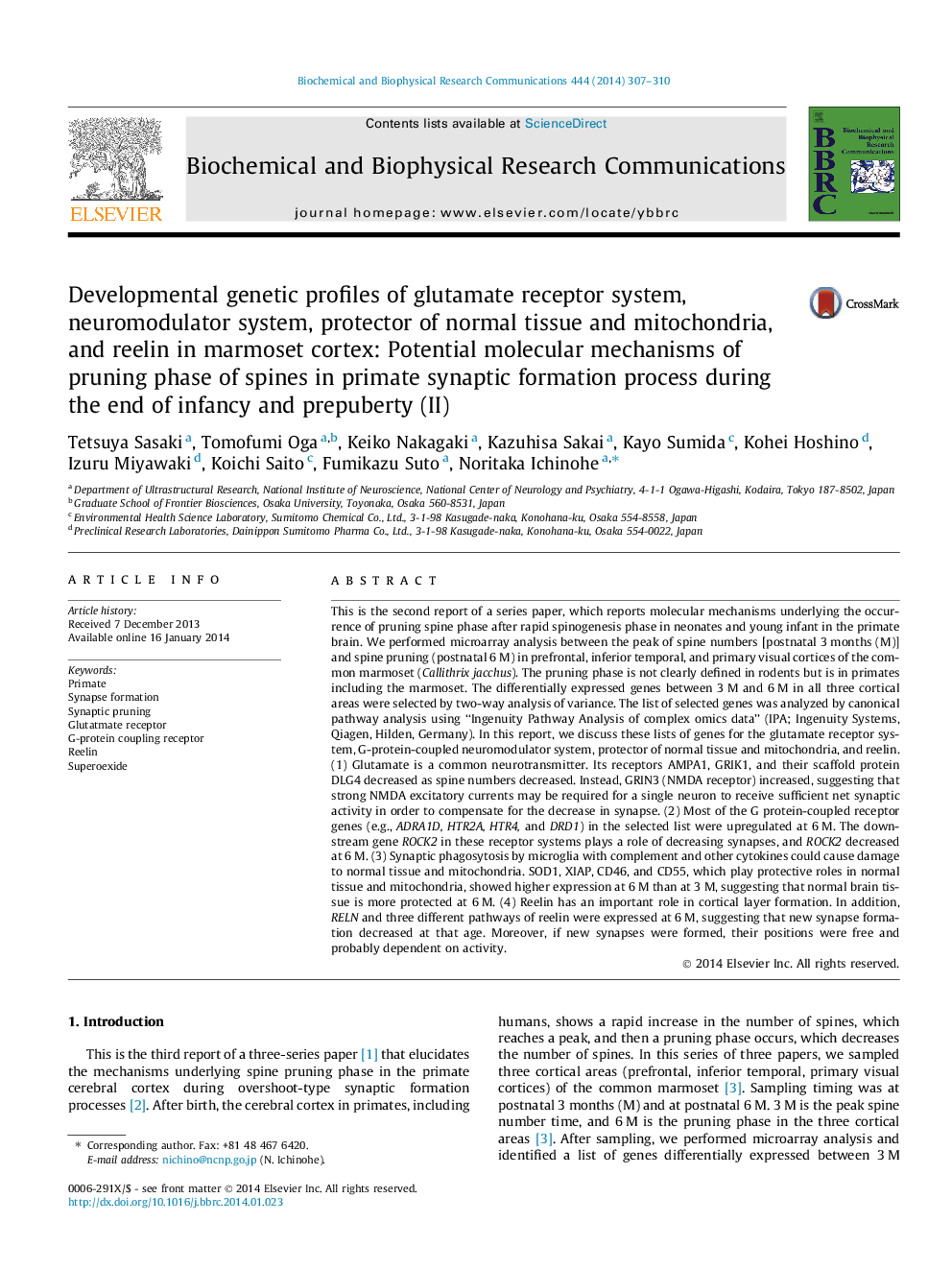| کد مقاله | کد نشریه | سال انتشار | مقاله انگلیسی | نسخه تمام متن |
|---|---|---|---|---|
| 10756919 | 1050389 | 2014 | 4 صفحه PDF | دانلود رایگان |
عنوان انگلیسی مقاله ISI
Developmental genetic profiles of glutamate receptor system, neuromodulator system, protector of normal tissue and mitochondria, and reelin in marmoset cortex: Potential molecular mechanisms of pruning phase of spines in primate synaptic formation process
دانلود مقاله + سفارش ترجمه
دانلود مقاله ISI انگلیسی
رایگان برای ایرانیان
کلمات کلیدی
موضوعات مرتبط
علوم زیستی و بیوفناوری
بیوشیمی، ژنتیک و زیست شناسی مولکولی
زیست شیمی
پیش نمایش صفحه اول مقاله

چکیده انگلیسی
This is the second report of a series paper, which reports molecular mechanisms underlying the occurrence of pruning spine phase after rapid spinogenesis phase in neonates and young infant in the primate brain. We performed microarray analysis between the peak of spine numbers [postnatal 3Â months (M)] and spine pruning (postnatal 6Â M) in prefrontal, inferior temporal, and primary visual cortices of the common marmoset (Callithrix jacchus). The pruning phase is not clearly defined in rodents but is in primates including the marmoset. The differentially expressed genes between 3Â M and 6Â M in all three cortical areas were selected by two-way analysis of variance. The list of selected genes was analyzed by canonical pathway analysis using “Ingenuity Pathway Analysis of complex omics data” (IPA; Ingenuity Systems, Qiagen, Hilden, Germany). In this report, we discuss these lists of genes for the glutamate receptor system, G-protein-coupled neuromodulator system, protector of normal tissue and mitochondria, and reelin. (1) Glutamate is a common neurotransmitter. Its receptors AMPA1, GRIK1, and their scaffold protein DLG4 decreased as spine numbers decreased. Instead, GRIN3 (NMDA receptor) increased, suggesting that strong NMDA excitatory currents may be required for a single neuron to receive sufficient net synaptic activity in order to compensate for the decrease in synapse. (2) Most of the G protein-coupled receptor genes (e.g., ADRA1D, HTR2A, HTR4, and DRD1) in the selected list were upregulated at 6Â M. The downstream gene ROCK2 in these receptor systems plays a role of decreasing synapses, and ROCK2 decreased at 6Â M. (3) Synaptic phagosytosis by microglia with complement and other cytokines could cause damage to normal tissue and mitochondria. SOD1, XIAP, CD46, and CD55, which play protective roles in normal tissue and mitochondria, showed higher expression at 6Â M than at 3Â M, suggesting that normal brain tissue is more protected at 6Â M. (4) Reelin has an important role in cortical layer formation. In addition, RELN and three different pathways of reelin were expressed at 6Â M, suggesting that new synapse formation decreased at that age. Moreover, if new synapses were formed, their positions were free and probably dependent on activity.
ناشر
Database: Elsevier - ScienceDirect (ساینس دایرکت)
Journal: Biochemical and Biophysical Research Communications - Volume 444, Issue 3, 14 February 2014, Pages 307-310
Journal: Biochemical and Biophysical Research Communications - Volume 444, Issue 3, 14 February 2014, Pages 307-310
نویسندگان
Tetsuya Sasaki, Tomofumi Oga, Keiko Nakagaki, Kazuhisa Sakai, Kayo Sumida, Kohei Hoshino, Izuru Miyawaki, Koichi Saito, Fumikazu Suto, Noritaka Ichinohe,